warning Hyundai Accent 2007 Owner's Guide
[x] Cancel search | Manufacturer: HYUNDAI, Model Year: 2007, Model line: Accent, Model: Hyundai Accent 2007Pages: 282, PDF Size: 10.55 MB
Page 44 of 282
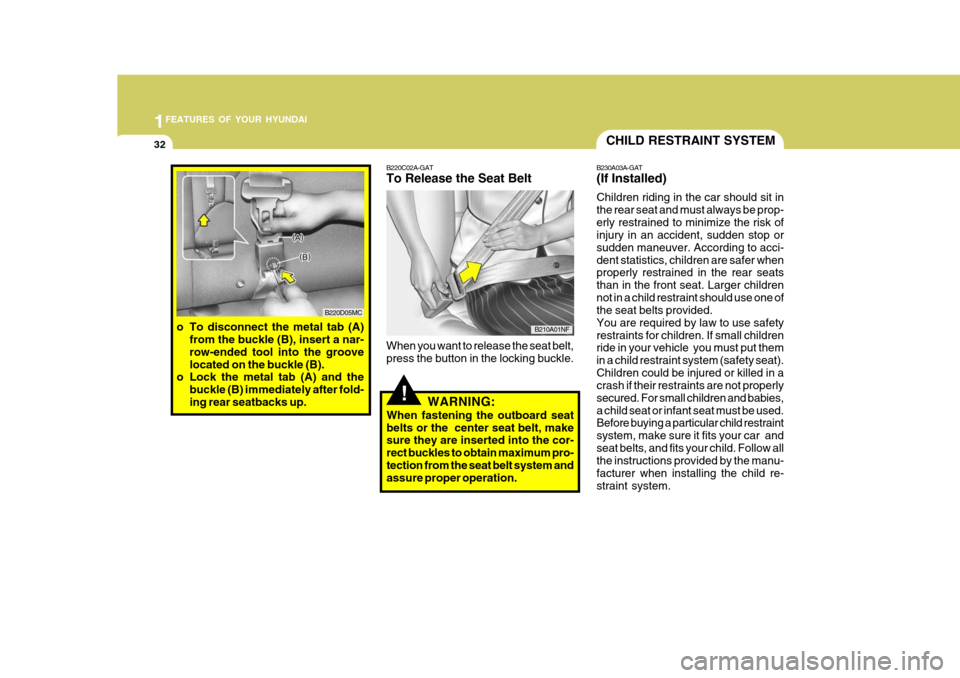
1FEATURES OF YOUR HYUNDAI
32
!
B220C02A-GAT To Release the Seat Belt When you want to release the seat belt, press the button in the locking buckle.
WARNING:
When fastening the outboard seatbelts or the center seat belt, make sure they are inserted into the cor- rect buckles to obtain maximum pro-tection from the seat belt system and assure proper operation.
B210A01NF
CHILD RESTRAINT SYSTEM
B230A03A-GAT (If Installed) Children riding in the car should sit in the rear seat and must always be prop-erly restrained to minimize the risk of injury in an accident, sudden stop or sudden maneuver. According to acci-dent statistics, children are safer when properly restrained in the rear seats than in the front seat. Larger childrennot in a child restraint should use one of the seat belts provided. You are required by law to use safetyrestraints for children. If small children ride in your vehicle you must put them in a child restraint system (safety seat).Children could be injured or killed in a crash if their restraints are not properly secured. For small children and babies,a child seat or infant seat must be used. Before buying a particular child restraint system, make sure it fits your car andseat belts, and fits your child. Follow all the instructions provided by the manu- facturer when installing the child re-straint system.
B220D05MC
o To disconnect the metal tab (A) from the buckle (B), insert a nar- row-ended tool into the groovelocated on the buckle (B).
o Lock the metal tab (A) and the
buckle (B) immediately after fold-ing rear seatbacks up.
Page 45 of 282
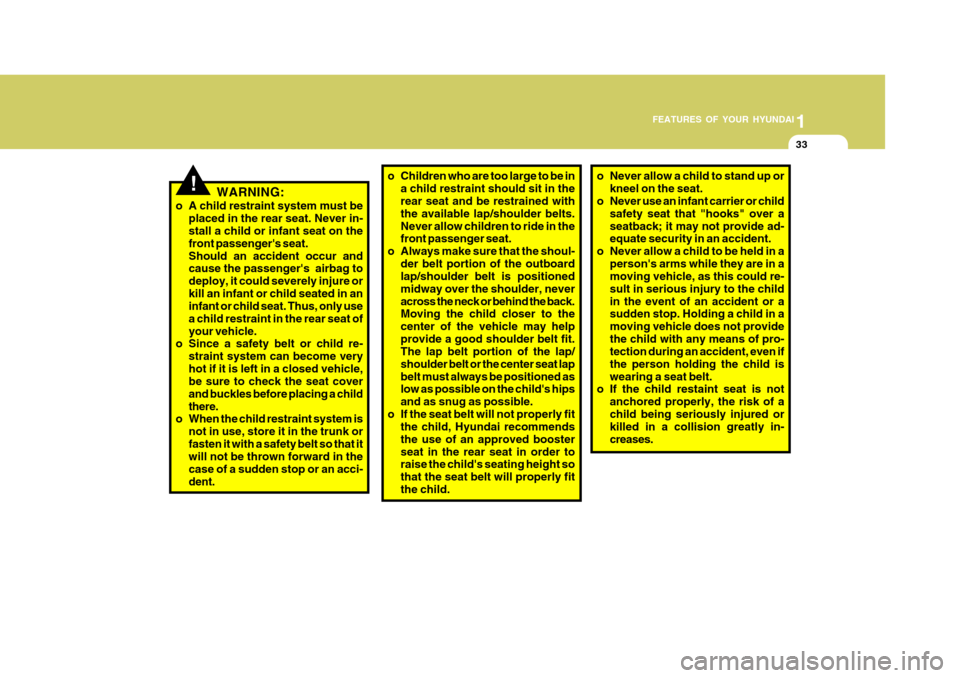
1
FEATURES OF YOUR HYUNDAI
33
WARNING:
o A child restraint system must be placed in the rear seat. Never in- stall a child or infant seat on the front passenger's seat.Should an accident occur and cause the passenger's airbag to deploy, it could severely injure orkill an infant or child seated in an infant or child seat. Thus, only use a child restraint in the rear seat ofyour vehicle.
o Since a safety belt or child re-
straint system can become veryhot if it is left in a closed vehicle, be sure to check the seat cover and buckles before placing a childthere.
o When the child restraint system is
not in use, store it in the trunk orfasten it with a safety belt so that it will not be thrown forward in the case of a sudden stop or an acci-dent.!o Children who are too large to be ina child restraint should sit in the rear seat and be restrained with the available lap/shoulder belts.Never allow children to ride in the front passenger seat.
o Always make sure that the shoul-
der belt portion of the outboardlap/shoulder belt is positioned midway over the shoulder, neveracross the neck or behind the back. Moving the child closer to the center of the vehicle may helpprovide a good shoulder belt fit. The lap belt portion of the lap/ shoulder belt or the center seat lapbelt must always be positioned as low as possible on the child's hips and as snug as possible.
o If the seat belt will not properly fit the child, Hyundai recommendsthe use of an approved boosterseat in the rear seat in order to raise the child's seating height so that the seat belt will properly fitthe child.o Never allow a child to stand up or
kneel on the seat.
o Never use an infant carrier or child
safety seat that "hooks" over a seatback; it may not provide ad- equate security in an accident.
o Never allow a child to be held in a
person's arms while they are in amoving vehicle, as this could re- sult in serious injury to the childin the event of an accident or a sudden stop. Holding a child in a moving vehicle does not providethe child with any means of pro- tection during an accident, even if the person holding the child iswearing a seat belt.
o If the child restaint seat is not
anchored properly, the risk of achild being seriously injured or killed in a collision greatly in- creases.
Page 47 of 282
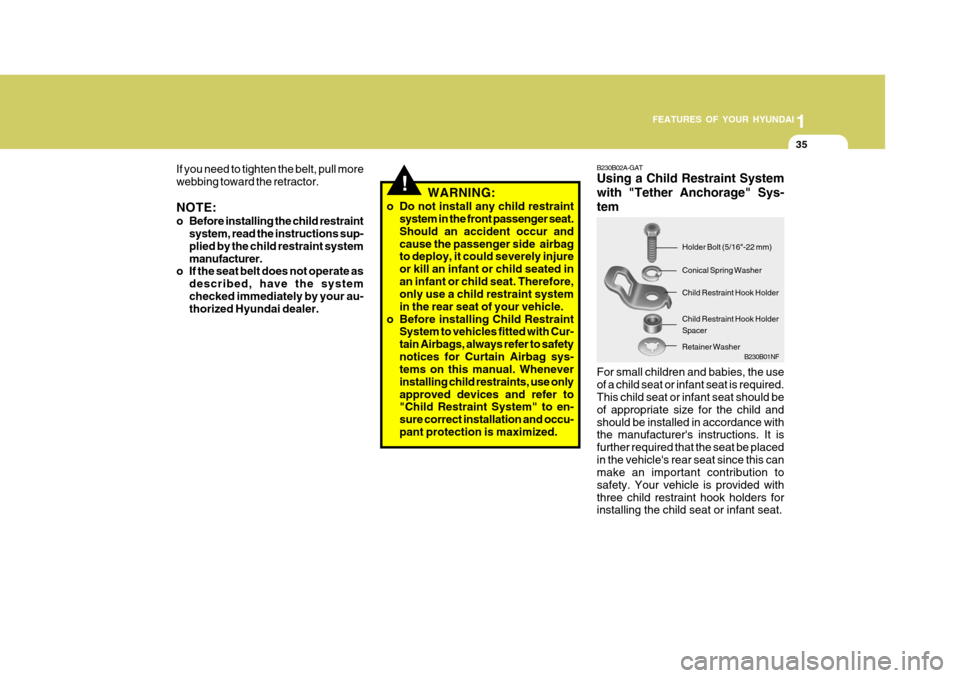
1
FEATURES OF YOUR HYUNDAI
35
If you need to tighten the belt, pull more webbing toward the retractor. NOTE:
o Before installing the child restraint system, read the instructions sup- plied by the child restraint systemmanufacturer.
o If the seat belt does not operate as
described, have the systemchecked immediately by your au- thorized Hyundai dealer.
!
B230B01NF
WARNING:
o Do not install any child restraint system in the front passenger seat. Should an accident occur andcause the passenger side airbag to deploy, it could severely injure or kill an infant or child seated inan infant or child seat. Therefore, only use a child restraint system in the rear seat of your vehicle.
o Before installing Child Restraint System to vehicles fitted with Cur-tain Airbags, always refer to safetynotices for Curtain Airbag sys- tems on this manual. Whenever installing child restraints, use onlyapproved devices and refer to "Child Restraint System" to en- sure correct installation and occu-pant protection is maximized. Child Restraint Hook Holder Spacer
B230B02A-GAT Using a Child Restraint System with "Tether Anchorage" Sys-tem For small children and babies, the use of a child seat or infant seat is required. This child seat or infant seat should be of appropriate size for the child andshould be installed in accordance with the manufacturer's instructions. It is further required that the seat be placedin the vehicle's rear seat since this can make an important contribution to safety. Your vehicle is provided withthree child restraint hook holders for installing the child seat or infant seat. Holder Bolt (5/16"-22 mm) Conical Spring Washer Child Restraint Hook Holder
Retainer Washer
Page 50 of 282

1FEATURES OF YOUR HYUNDAI
38
WARNING:
o Do not install a child restraint seat at the center of the rear seat using the vehicle's ISOFIX anchors. The ISOFIX anchors are only providedfor the left and right outboard rear seating positions. Do not misuse the ISOFIX anchors by attemptingto attach a child restraint seat in the middle of the rear seat to the ISOFIX anchors. In a crash, thechild restraint seat ISOFIX attach- ments may not be strong enough to secure the child restraint seatproperly in the center of the rear seat and may break, causing seri- ous injury or death.
o When using the vehicle’s "ISOFIX" system to install a child restraintsystem in the rear seat, all unusedvehicle rear seat belt metal latch plates or tabs must be latched securely in their seat belt bucklesand the seat belt webbing must be retracted behind the child restraint to prevent the child from reachingand taking hold of unretracted seat
belts. Unlatched metal latch plates
B230D03MC
1. To engage the child restraint seat to the ISOFIX anchor, insert the child restraint seat latch into the ISOFIX anchor. Listen for the audible "click" sound.
2. Connect the tether strap hook to the child restraint hook holder and tightento secure the seat. Refer to "Secur-ing a Child Restraint System with the Tether Anchorage System" on page 1-36.
To secure the child restraint seat!
On each side of the rear seat, between the cushion and backrest, are located apair of ISOFIX anchorage points to- gether with a top tether mounting on the rear seat package tray (4 Door) or therear floor panel (3 Door). During the installing, the seat has to be engaged at the anchorage-points in away you can hear it clicking (check by pulling!) and has to be fixed with the Top Tether-belt on the belonging point of therear seat package tray (4 Door) or rear floor panel (3 Door). The installing and the use of a child-seat has to be doneaccording to the installing-manual, which is added to the ISOFIX-seat. NOTE: An ISOFIX-child-seat can only be installed if the seat has a vehicle- specific approval according to ECE- R44. Before using the ISOFIX-child-seat, which was bought for another car, ask your Hyundai-dealer whether this seat-type is approved and rec-ommended for your Hyundai.
Page 52 of 282
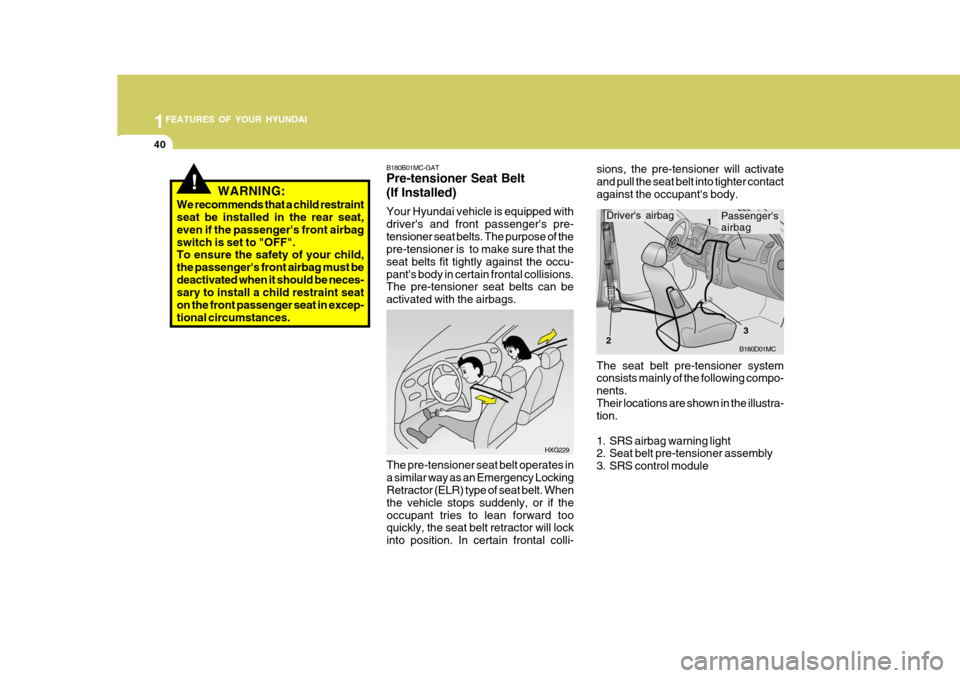
1FEATURES OF YOUR HYUNDAI
40
The seat belt pre-tensioner system consists mainly of the following compo- nents.Their locations are shown in the illustra- tion.
1. SRS airbag warning light
2. Seat belt pre-tensioner assembly
3. SRS control module
Passenger's airbag
B180D01MC
Driver's airbag1
2 3
sions, the pre-tensioner will activate and pull the seat belt into tighter contactagainst the occupant's body.
HXG229
B180B01MC-GAT Pre-tensioner Seat Belt (If Installed) Your Hyundai vehicle is equipped with driver's and front passenger's pre-tensioner seat belts. The purpose of the pre-tensioner is to make sure that the seat belts fit tightly against the occu-pant's body in certain frontal collisions. The pre-tensioner seat belts can be activated with the airbags.
The pre-tensioner seat belt operates ina similar way as an Emergency Locking Retractor (ELR) type of seat belt. When the vehicle stops suddenly, or if theoccupant tries to lean forward too quickly, the seat belt retractor will lock into position. In certain frontal colli-
!WARNING:
We recommends that a child restraint seat be installed in the rear seat, even if the passenger's front airbagswitch is set to "OFF". To ensure the safety of your child, the passenger's front airbag must bedeactivated when it should be neces- sary to install a child restraint seat on the front passenger seat in excep-tional circumstances.
Page 53 of 282
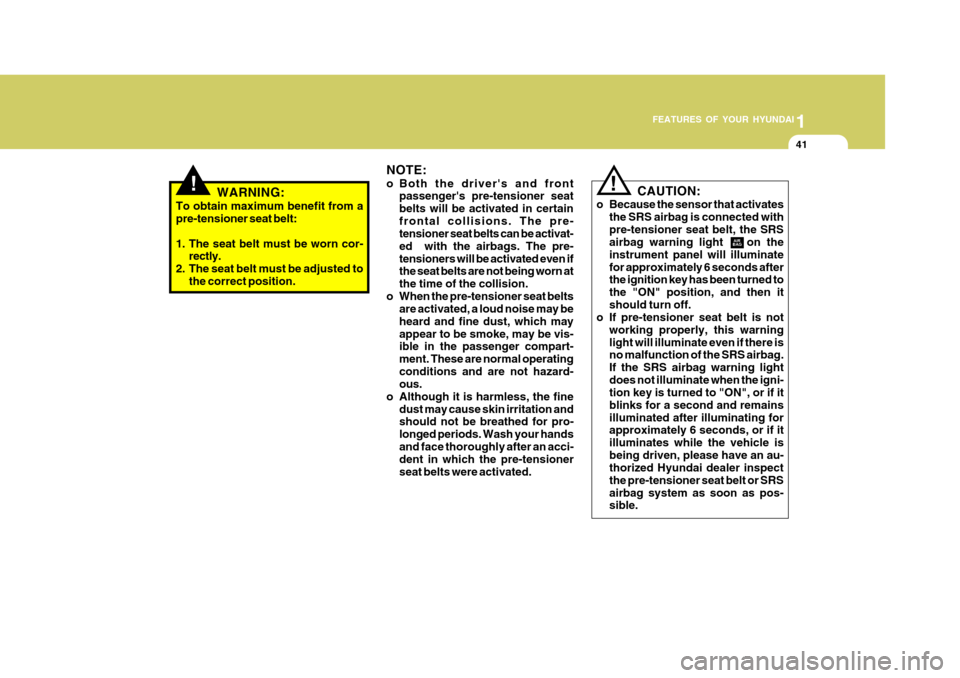
1
FEATURES OF YOUR HYUNDAI
41
!WARNING:
To obtain maximum benefit from a pre-tensioner seat belt:
1. The seat belt must be worn cor- rectly.
2. The seat belt must be adjusted to the correct position. NOTE:
o Both the driver's and front
passenger's pre-tensioner seat belts will be activated in certainfrontal collisions. The pre- tensioner seat belts can be activat- ed with the airbags. The pre-tensioners will be activated even if the seat belts are not being worn at the time of the collision.
o When the pre-tensioner seat belts are activated, a loud noise may beheard and fine dust, which mayappear to be smoke, may be vis- ible in the passenger compart- ment. These are normal operatingconditions and are not hazard- ous.
o Although it is harmless, the fine dust may cause skin irritation andshould not be breathed for pro- longed periods. Wash your handsand face thoroughly after an acci- dent in which the pre-tensioner seat belts were activated.! CAUTION:
o Because the sensor that activates the SRS airbag is connected with pre-tensioner seat belt, the SRS airbag warning light on the instrument panel will illuminatefor approximately 6 seconds after the ignition key has been turned to the "ON" position, and then itshould turn off.
o If pre-tensioner seat belt is not
working properly, this warninglight will illuminate even if there is no malfunction of the SRS airbag. If the SRS airbag warning lightdoes not illuminate when the igni- tion key is turned to "ON", or if it blinks for a second and remainsilluminated after illuminating for approximately 6 seconds, or if it illuminates while the vehicle isbeing driven, please have an au- thorized Hyundai dealer inspect the pre-tensioner seat belt or SRSairbag system as soon as pos- sible.
Page 54 of 282
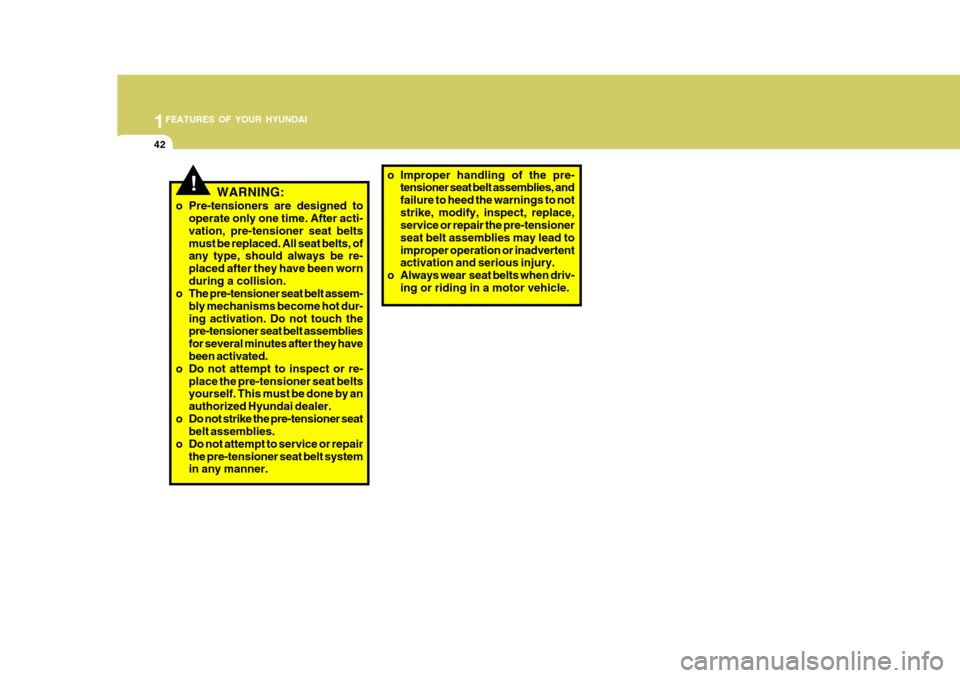
1FEATURES OF YOUR HYUNDAI
42
o Improper handling of the pre-
tensioner seat belt assemblies, and failure to heed the warnings to notstrike, modify, inspect, replace, service or repair the pre-tensioner seat belt assemblies may lead toimproper operation or inadvertent activation and serious injury.
o Always wear seat belts when driv-
ing or riding in a motor vehicle.
!WARNING:
o Pre-tensioners are designed to operate only one time. After acti- vation, pre-tensioner seat beltsmust be replaced. All seat belts, of any type, should always be re- placed after they have been wornduring a collision.
o The pre-tensioner seat belt assem-
bly mechanisms become hot dur-ing activation. Do not touch the pre-tensioner seat belt assemblies for several minutes after they have been activated.
o Do not attempt to inspect or re-
place the pre-tensioner seat beltsyourself. This must be done by an authorized Hyundai dealer.
o Do not strike the pre-tensioner seat belt assemblies.
o Do not attempt to service or repair the pre-tensioner seat belt system in any manner.
Page 56 of 282
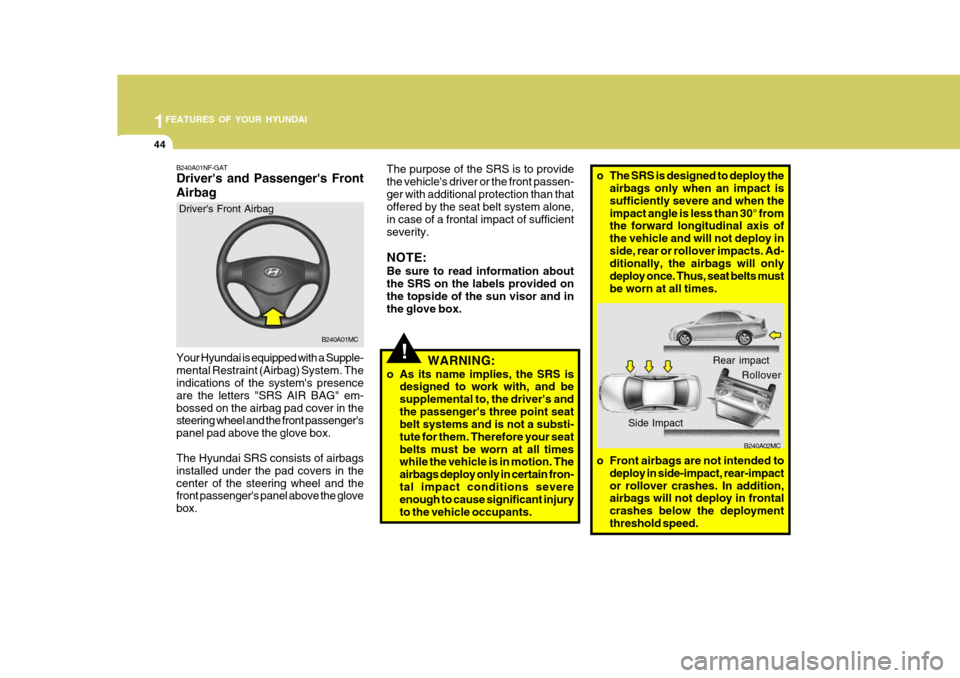
1FEATURES OF YOUR HYUNDAI
44
B240A01MC
Driver's Front Airbag
Your Hyundai is equipped with a Supple- mental Restraint (Airbag) System. The indications of the system's presence are the letters "SRS AIR BAG" em-bossed on the airbag pad cover in the steering wheel and the front passenger's panel pad above the glove box. The Hyundai SRS consists of airbags installed under the pad covers in thecenter of the steering wheel and the front passenger's panel above the glove box.
B240A01NF-GAT Driver's and Passenger's Front Airbag
!
o The SRS is designed to deploy the
airbags only when an impact is sufficiently severe and when theimpact angle is less than 30° from the forward longitudinal axis of the vehicle and will not deploy inside, rear or rollover impacts. Ad- ditionally, the airbags will only deploy once. Thus, seat belts mustbe worn at all times.
o Front airbags are not intended to deploy in side-impact, rear-impactor rollover crashes. In addition, airbags will not deploy in frontal crashes below the deploymentthreshold speed.
The purpose of the SRS is to providethe vehicle's driver or the front passen-ger with additional protection than that offered by the seat belt system alone, in case of a frontal impact of sufficientseverity. NOTE: Be sure to read information about the SRS on the labels provided onthe topside of the sun visor and in the glove box.
WARNING:
o As its name implies, the SRS is designed to work with, and be supplemental to, the driver's andthe passenger's three point seat belt systems and is not a substi- tute for them. Therefore your seatbelts must be worn at all times while the vehicle is in motion. The airbags deploy only in certain fron-tal impact conditions severe enough to cause significant injury to the vehicle occupants.
B240A02MC
Rear impact
Side Impact Rollover
Page 59 of 282
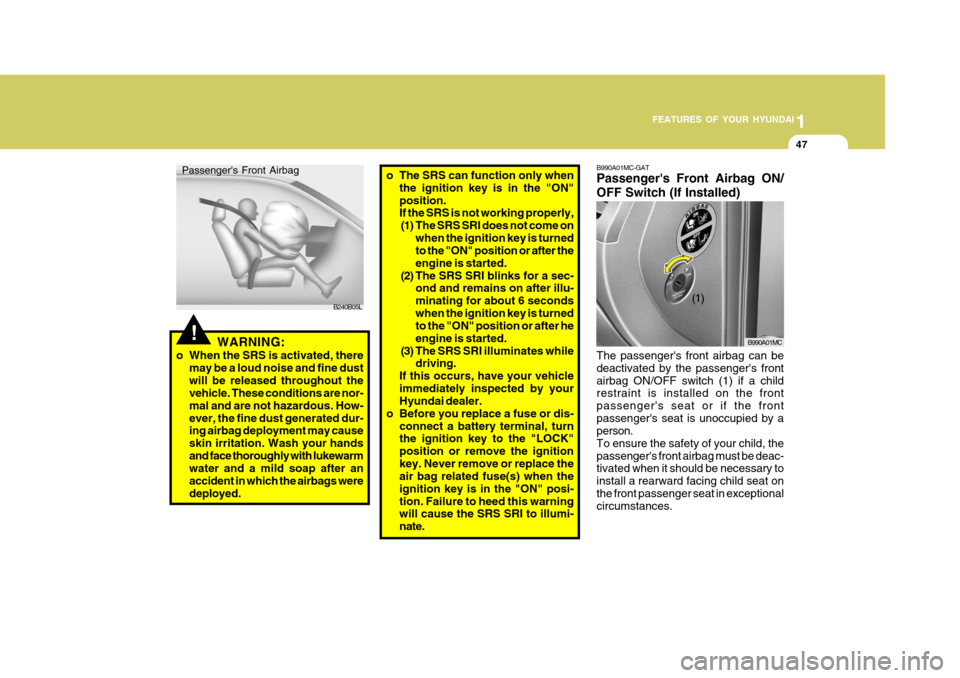
1
FEATURES OF YOUR HYUNDAI
47
o The SRS can function only when
the ignition key is in the "ON" position. If the SRS is not working properly,(1) The SRS SRI does not come on
when the ignition key is turnedto the "ON" position or after the engine is started.
(2) The SRS SRI blinks for a sec- ond and remains on after illu-minating for about 6 secondswhen the ignition key is turned to the "ON" position or after he engine is started.
(3) The SRS SRI illuminates while driving.
If this occurs, have your vehicleimmediately inspected by your Hyundai dealer.
o Before you replace a fuse or dis- connect a battery terminal, turnthe ignition key to the "LOCK" position or remove the ignitionkey. Never remove or replace the air bag related fuse(s) when the ignition key is in the "ON" posi-tion. Failure to heed this warning will cause the SRS SRI to illumi- nate.
!WARNING:
o When the SRS is activated, there may be a loud noise and fine dust will be released throughout the vehicle. These conditions are nor- mal and are not hazardous. How-ever, the fine dust generated dur- ing airbag deployment may cause skin irritation. Wash your handsand face thoroughly with lukewarm water and a mild soap after an accident in which the airbags weredeployed.
Passenger's Front Airbag
B240B05LB990A01MC-GAT Passenger's Front Airbag ON/ OFF Switch (If Installed)
B990A01MC
The passenger's front airbag can be deactivated by the passenger's frontairbag ON/OFF switch (1) if a child restraint is installed on the front passenger's seat or if the frontpassenger's seat is unoccupied by a person. To ensure the safety of your child, thepassenger's front airbag must be deac- tivated when it should be necessary to install a rearward facing child seat onthe front passenger seat in exceptional circumstances. (1)
Page 60 of 282
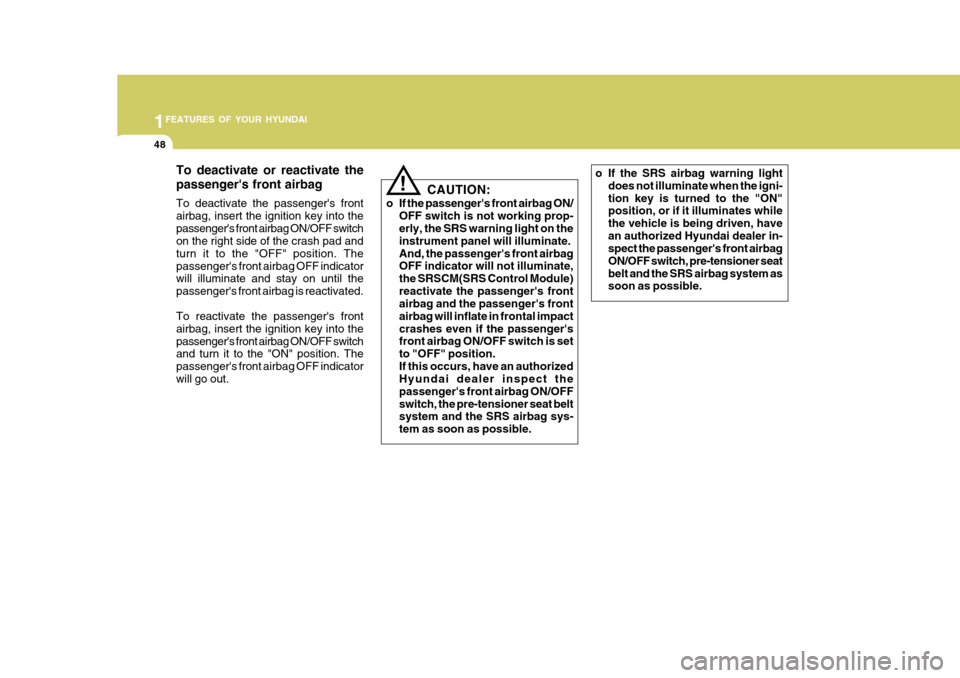
1FEATURES OF YOUR HYUNDAI
48
o If the SRS airbag warning lightdoes not illuminate when the igni- tion key is turned to the "ON" position, or if it illuminates while the vehicle is being driven, havean authorized Hyundai dealer in- spect the passenger's front airbag ON/OFF switch, pre-tensioner seatbelt and the SRS airbag system as soon as possible.
! CAUTION:
o If the passenger's front airbag ON/ OFF switch is not working prop- erly, the SRS warning light on the instrument panel will illuminate.And, the passenger's front airbag OFF indicator will not illuminate, the SRSCM(SRS Control Module)reactivate the passenger's front airbag and the passenger's front airbag will inflate in frontal impactcrashes even if the passenger's front airbag ON/OFF switch is set to "OFF" position.If this occurs, have an authorized Hyundai dealer inspect the passenger's front airbag ON/OFFswitch, the pre-tensioner seat belt system and the SRS airbag sys- tem as soon as possible.
To deactivate or reactivate the passenger's front airbag To deactivate the passenger's front airbag, insert the ignition key into thepassenger's front airbag ON/OFF switch on the right side of the crash pad and turn it to the "OFF" position. Thepassenger's front airbag OFF indicator will illuminate and stay on until the passenger's front airbag is reactivated. To reactivate the passenger's front airbag, insert the ignition key into thepassenger's front airbag ON/OFF switch and turn it to the "ON" position. The passenger's front airbag OFF indicatorwill go out.